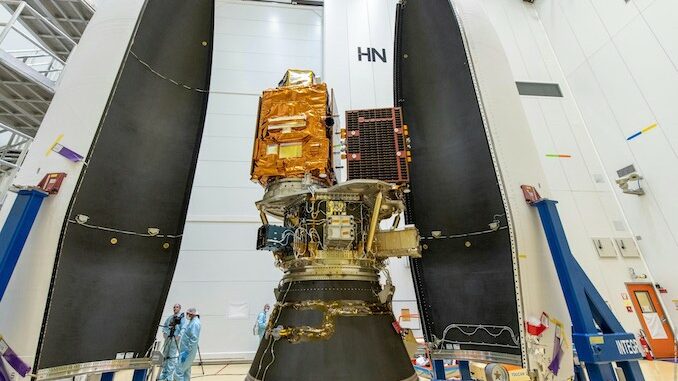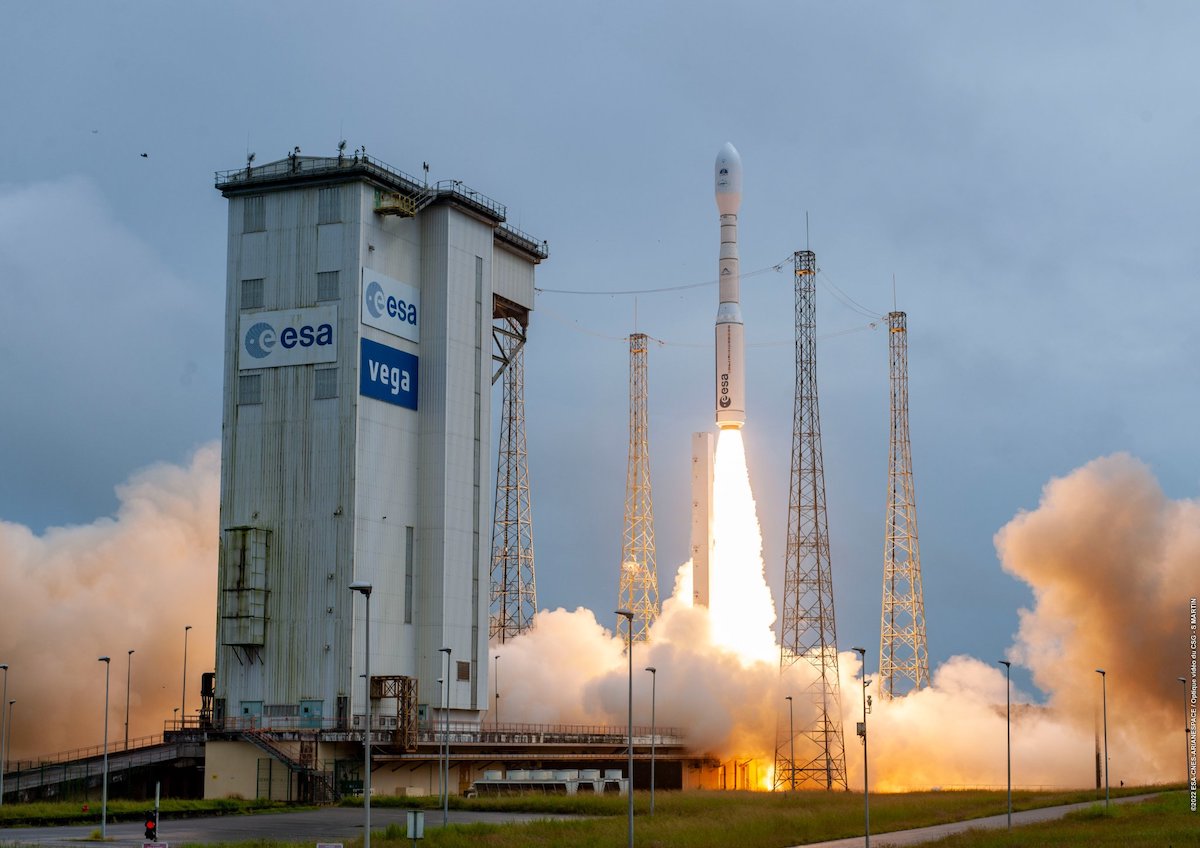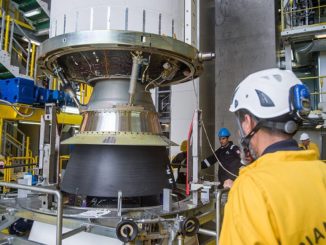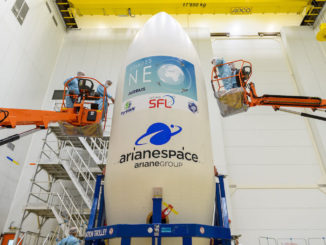Update 10 p.m. EDT (0200 UTC) Sunday: Vega lifted off at 9:36 p.m. EDT (0138 UTC) on Sunday after a two-day delay.

A pair of Earth observation satellites along with ten auxiliary payloads will launch aboard Arianespace’s penultimate Vega rocket into sun-synchronous orbit on Friday. The light launch vehicle, which began flying in 2012, is set to liftoff from Europe’s Spaceport in French Guiana on Oct. 6 at 10:36 p.m. local time (9:36 p.m. EDT, 0136 UTC).
The main payloads consist the Thailand Earth Observation System-2 (THEOS-2) for the Geo-Informatics and Space Technology Development Agency (GISTDA) and the Triton spacecraft (also known as Formosat-7R) for the Taiwan Space Agency (TASA).
THEOS-2 is considered the primary payload and is described as “a high-resolution Earth observation optical satellite,” which uses 0.5-meter ground resolution imagery to support the operations of THEOS-1, which launched back in 2008.
The project was approved back in 2017 by the Thai government with a price tag of about $238 million, according to the European Space Agency (ESA).
“The platform will host and exploit multi-source data in an interoperable and integrated manner,” said Dr. Anond Snidvongs, the executive director of GISTDA, in a statement. “The resulting insights will be key sources of information for Thai leaders and will help them deliver Actionable Intelligence Policy (AIP): tools for area-based management and decision-making.”
The spacecraft weighs about 425 kg (approx. 937 lbs.) and is designed to orbit the Earth at 621 km and is designed to last for a decade. It can be tilted 45 degrees for photography.
The secondary payload, Triton, nicknamed the “Wind-Hunter Satellite” by TASA, weighs about 250 kg (approx. 551 lbs.) and features an instrument called the Global Navigation Satellite System-Reflectometry (GNSS-R). It collects GNSS data from the ocean to establish wind fields and better research things like air-sea interactions and typhoon intensities.
https://twitter.com/TASA_Taiwan/status/1698711594992316590
Also onboard the Vega rocket will be ten additional payloads on behalf of six customers:
-
- Instituto Nacional de Técnica Aerospacial (INTA)
- ANSWER (Advanced Nanosatellite Systems for Earth observation Research) Leader
- ANSWER Follower 1
- ANSWER Follower 2
- University of Tartu (Estonia)
- ESTCube-2
- Centre National D’études Spatiales (CNES)
- N2SS (Nanosat 3U pour la Surveillance du Spectre)
- SAB Launch Services
- PRETTY (Passive REflecTomeTry and dosimetrY) for Beyond Gravity Austria
- Macsat IoD (in-orbit demonstration) for the Luxembourg Space Agency
- ESA
- PVCC (Proba-V Companion CubeSat)
- European Union IOD/IOV program
- CSC- (CubeSat Carrier) 1 & 2, an aggregation of seven payloads from five countries: Belgium, Czechia, Estonia, France and Spain
- Instituto Nacional de Técnica Aerospacial (INTA)
Transition to Vega-C
Friday’s launch will be the penultimate flight for the Vega rocket in its current iteration. A spokesperson with Arianespace confirmed to Spaceflight Now on Thursday that the final Vega rocket is expected to launch in the first quarter of 2024.
ESA and Arianespace were in the midst of transitioning to the upgraded Vega-C rocket, but plans have stalled for now after the rocket was grounded thanks to an in-flight failure during the rocket’s second mission.
About 151 seconds into the VV22 mission on Dec. 20, 2022, there was “a progressive decrease in the chamber pressure” on the second stage of the rocket (Zeifro40). An Independent Enquiry Commission (IEC) was formed following the mishap, which resulted in the loss of a pair of Earth observation satellites from Airbus.
A task force established to implement the suggested improvements by the commission determined that they would aim for a return to flight mission by the end of 2023.

Another big setback came on June 28, 2023 during a static fire test of the modified Zefiro40 engine. Investigators determined that “the combination of the geometry of the Carbon-Carbon throat insert and the different thermo-mechanical properties of the new material” led to a failure of the engine nozzle at the Salt di Quire test facility in Italy.
On Oct. 2, ESA announced additional recommendations from the IEC, including:
-
- A design change to the Zefiro40 nozzle technical reviews
- Conduct two additional test firings to verify performance
The new requirements mean that the return to flight of Vega-C will now push back to the fourth quarter of 2024.
The struggles of the Vega-C rocket and its predecessor has forced customers to make changes. The Italian Space Agency (ASI) pointed to first generation Vega rocket failures in 2019 and 2020, which delayed the maiden flight of the Vega-C rocket when they shifted their COSMO SkyMed Second Generation (CSG-2) satellite from a planned 2021 Vega-C flight onto a SpaceX Falcon 9 rocket, which successfully launched in January 2022.
The EarthCARE ESA mission was also shifted from the Vega-C to the Falcon 9, which will launch sometime in 2024.



